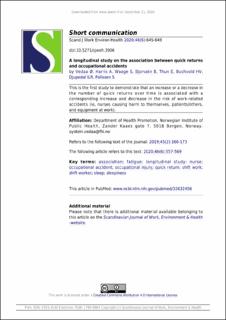| dc.contributor.author | Vedaa, Øystein | |
| dc.contributor.author | Harris, Anette | |
| dc.contributor.author | Waage, Siri | |
| dc.contributor.author | Bjorvatn, Bjørn | |
| dc.contributor.author | Thun, Eirunn | |
| dc.contributor.author | Buchvold, Hogne Vikanes | |
| dc.contributor.author | Djupedal, Ingebjørg Louise Rockwell | |
| dc.contributor.author | Pallesen, Ståle | |
| dc.date.accessioned | 2021-05-11T12:26:26Z | |
| dc.date.available | 2021-05-11T12:26:26Z | |
| dc.date.created | 2020-09-11T15:37:52Z | |
| dc.date.issued | 2020 | |
| dc.Published | Scandinavian Journal of Work, Environment and Health. 2020, . | |
| dc.identifier.issn | 0355-3140 | |
| dc.identifier.uri | https://hdl.handle.net/11250/2754937 | |
| dc.description.abstract | Objective: This study aimed to investigate how change in the number of quick returns [(QR) <11 hours between consecutive shifts] longitudinally is associated with risk of occupational accidents among nurses.
Methods: Two-year follow-up data from 1692 nurses participating in the Survey of Shiftwork, Sleep and Health among Norwegian nurses (SUSSH) (mean age 40.2, standard deviation 8.3 years, 91% female) were used. Negative binomial regression analyses were conducted to investigate the association between changes in the number of QR after two years and occupational accidents, controlling for demographics, work factors, and occupational accidents at baseline.
Results: An increase from having no or a moderate number of QR (1–34 per year) from baseline to the two-year follow-up assessment was associated with an increased risk of occupational accidents, compared to experiencing no change in the number of QR. Those with a moderate number of QR at baseline who experienced an increase after two years had an increased risk of causing harm to patients/others [incident rate ratio (IRR) 8.49, 95% confidence interval (CI) 2.79–25.87] and equipment at work (IRR 2.89, 95% CI 1.13–7.42). Those who had many QR (>34 per year) at baseline but experienced a reduction after two years had a reduced risk of causing harm to themselves (IRR 0.35, 95% CI 0.16–0.73) and patients/others (IRR 0.27, 95% CI 0.12–0.59).
Conclusion: A fairly consistent pattern was demonstrated in which changes in the number of QR over the two-year follow-up period was associated with a corresponding change in the risk of occupational accidents. | en_US |
| dc.language.iso | eng | en_US |
| dc.publisher | Nordic Association of Occupational Safety and Health (NOROSH) | en_US |
| dc.rights | Navngivelse 4.0 Internasjonal | * |
| dc.rights.uri | http://creativecommons.org/licenses/by/4.0/deed.no | * |
| dc.title | A longitudinal study on the association between quick returns and occupational accidents | en_US |
| dc.type | Journal article | en_US |
| dc.description.version | publishedVersion | en_US |
| dc.rights.holder | Copyright Scandinavian Journal of Work, Environment & Health | en_US |
| cristin.ispublished | true | |
| cristin.fulltext | original | |
| cristin.qualitycode | 1 | |
| dc.identifier.doi | 10.5271/sjweh.3906 | |
| dc.identifier.cristin | 1829181 | |
| dc.source.journal | Scandinavian Journal of Work, Environment and Health | en_US |
| dc.source.pagenumber | 645-649 | en_US |
| dc.identifier.citation | Scandinavian Journal of Work, Environment and Health. 2020, 46 (6), 645-649. | en_US |
| dc.source.volume | 46 | en_US |
| dc.source.issue | 6 | en_US |

